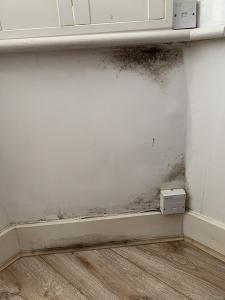Mini case study on condensation
Here we can see very good evidence of condensation under a bay window. The coldest three places are under the sill due to thermal bridging effects of the stone sill and the proximity of the window opening. The skirting is getting very cold and picking up condensation and some level of mould growth too. Most likely there is a cold draughty void behind the skirting exacerbating the problem of it being cold.Around the telephone socket, the coldest bit of the wall will always be a low down internal corner .
Next pic behind the sofa:-
This sofa had been pushed back into the corner and when moved out revealed the problem. When in position it was actually slightly insulating the wall and corner from the heat of the room, and reducing air circulation that would also transport some heat there. Once condensation formed it could not easily escape and soaked in damaging the decorations. Again the low down internal corner was already the coldest point so is the worst place for mould growth.
Many people think that for condensation to occur damp air needs to move to the point where it can condense. This is not the case as moisture can move through air without the air itself moving! Also keeping the RH indoors low does not help as when air cools like behind the sofa for instance its RH rises, when this reaches dew-point condensation happens and moisture is literally sucked from the whole room or house to that point until the air is dry enough for it to be above dew point where the condensation is taking place (not in the house or room).


